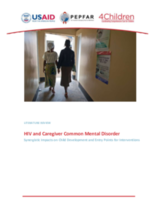Executive Summary
INTRODUCTION
For children to thrive they must have their needs met in multiple domains and across the life-course; yet, millions of children under the age of five will not meet their developmental potential. Part of the reason for this is due to the burden of HIV coupled with the high prevalence rate of common mental disorders in many low- and middle-income countries (LMICs). In this paper we review published literature on the mental health status of mothers living with HIV (MLH) and how this affects their children; we outline the pathways between maternal HIV, maternal mental health problems, and negative child outcomes; and then describe a number of intervention entry points that we argue have the potential to enhance impact across PEPFAR platforms.
METHOD OF REVIEW
Papers were considered eligible for inclusion if they pertained to HIV; mothers living with HIV and their children; the psychosocial correlates of HIV; and depression as a risk factor. Studies were identified using the following search terms (HIV; AIDS; mothers living with HIV; MLH; children affected by HIV; AIDS-affected children; depression; maternal depression; maternal mental health; families affected by HIV; HIV-affected families; and AIDS orphan) and a search of the following electronic databases: PubMed, Medline, The Cochrane Library, PsycINFO, EBSCO Host, and Google Scholar.
DISCUSSION
Poverty, HIV and mental health problems present a cumulative and mutually reinforcing burden for women in LMICs: HIV puts women at risk for mental illness and mental illness puts women at risk for HIV, and that both conditions impact on caregiving; that children of mothers with HIV and mental disorder, and non-maternal caregivers with mental disorders are at especial risk of negative developmental outcomes; and that there is a cumulative negative impact of maternal or caregiver HIV and mental disorder on children.
IMPLICATIONS
Drawing on these findings, we outline possible entry points for intervention with particular emphasis on platforms of interest for PEPFAR programming. First and foremost, we highlight the importance of integrating screening for mental disorders into primary health care settings and at the community level. Secondly, we note that delivering effective interventions to caregivers and children in adverse settings will require a mix of types of interventions and delivery platforms. These include community platforms, such as community-based organizations, home visiting interventions and school-based platforms. At the level of health care, developing systems of collaborative stepped care to link communities to the health care system is imperative, as are family-based interventions. Finally, at the population level, structural interventions, such as microfinance and cash transfers, can address the structural drivers of HIV risk and mental illness, and are therefore essential in order to complement other preventive and curative efforts. Given the links between maternal mental health and maternal HIV and child outcomes, we also consider how targeted interventions might interrupt these pathways.
CONCLUSIONS AND RECOMMENDATIONS
This review shows that children affected by concurrent maternal HIV and depression may be more negatively affected than they would by either one on its own, and that the vulnerabilities they experience are multifaceted, enduring and may accumulate over time. These include vulnerability to negative outcomes in the realm of physical and emotional health, education and psychological adjustment. We argue that the links between HIV and mental health are bi-directional and cumulative. Finally, we describe a number of possible delivery platforms and types of intervention entry points with potential to enhance impact across PEPFAR platforms. We recommend a number of strategies to ensure a more integrated and holistic response to HIV infection, risk and caregiver depression.

